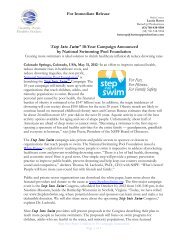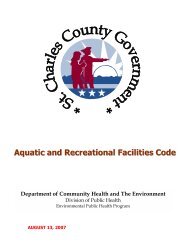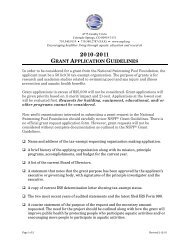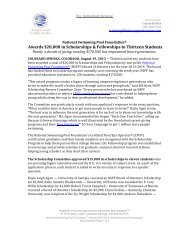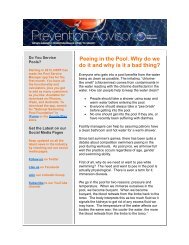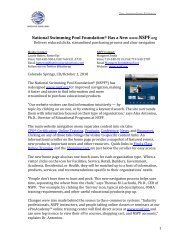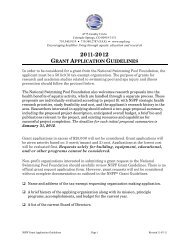English Instructor Manual (PDF) - Metric Version - National ...
English Instructor Manual (PDF) - Metric Version - National ...
English Instructor Manual (PDF) - Metric Version - National ...
You also want an ePaper? Increase the reach of your titles
YUMPU automatically turns print PDFs into web optimized ePapers that Google loves.
American Red Cross<br />
Consumer Product Safety Commission (CPSC)<br />
ASTM International (ASTM)<br />
NSF International (NSF)<br />
Underwriters Laboratories (UL)<br />
Regulations are “mandatory” rules that cannot be deviated from without permission<br />
from the regulation-setting agency. Failure to comply with regulations may result<br />
in monetary fi nes and disciplinary actions, such as facility closures. Organizations<br />
commonly setting aquatic regulations in the US include:<br />
Health departments<br />
Occupational Safety and Health Administration (OSHA)<br />
Environmental Protection Agency (EPA)<br />
Department of Transportation (DOT)<br />
Department of Justice (DOJ)<br />
Consumer Product Safety Commission (CPSC)<br />
Key Points: Explain that while all the organizations listed have an impact on the aquatics industry<br />
in some way, there are several that maintain a dominating presence. These include health<br />
departments, the Occupational Safety and Health Administration (OSHA), the Environmental<br />
Protection Agency (EPA), the Department of Justice, the Centers for Disease Control (CDC), and<br />
the Association of Pool and Spa Professionals (APSP) and American <strong>National</strong> Standards Institute<br />
(ANSI).<br />
Discuss the various aspects of health departments. These include:<br />
Health departments, more than any other regulating agency, have a direct day-to-day<br />
impact on the operation and management of aquatic facilities<br />
Health departments are sources for operating permits, site inspections, and regulations<br />
governing such things as, but not limited to, water quality standards (disinfection,<br />
bacterial limits, etc.), supervision requirements (lifeguards, etc.), operational parameters<br />
(fi lter sizes, turnover rates, etc.), swimmer capacity limits, and construction requirements<br />
Key Points: Discuss the various aspects of the Occupational Safety and Health Administration<br />
(OSHA). These include:<br />
OSHA is one of the most powerful agencies in federal government today. It regulates<br />
the “employer to employee” relationship of all labor.<br />
One of OSHA’s two most important regulations impacting the aquatics industry is the<br />
Hazard Communication Standard, also known as the “Employee Right to Know Law.” As<br />
it pertains to the aquatic industry, it regulates how pool operators handle equipment and<br />
chemicals that could be hazardous to their health and safety.<br />
The other important OSHA regulation that impacts the aquatics industry is the<br />
Bloodborne Pathogens Standard, which is also part of the Hazard Communication<br />
Standard. It regulates how to deal with employee exposure to blood and bodily fl uids.<br />
This is a considerable concern in the aquatic industry, especially with lifeguards who<br />
deal with cuts and scrapes on a daily basis.<br />
One of the most important OSHA tools used in protection of employees is the Material<br />
Safety Data Sheet (MSDS). An MSDS is required for every chemical stored and used in<br />
commercial applications. This includes pool chemicals, cleaning products, paints, etc.<br />
MSDSs should be posted near chemical storage and on fi le and must be available to all<br />
employees at no cost to them. MSDSs give valuable information about each chemical<br />
Page 44<br />
© 2014 <strong>National</strong> Swimming Pool Foundation®



